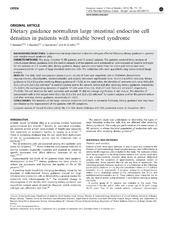Dietary guidance normalizes large intestinal endocrine cell densities in patients with irritable bowel syndrome
| dc.contributor.author | Mazzawi, Tarek | en_US |
| dc.contributor.author | Hausken, Trygve | en_US |
| dc.contributor.author | Gundersen, Doris Irene | en_US |
| dc.contributor.author | El-Salhy, Magdy | en_US |
| dc.date.accessioned | 2016-05-26T08:52:18Z | |
| dc.date.available | 2016-05-26T08:52:18Z | |
| dc.date.issued | 2015-11-25 | |
| dc.identifier.issn | 0954-3007 | |
| dc.identifier.uri | https://hdl.handle.net/1956/12011 | |
| dc.description.abstract | Background/Objectives: To determine the large intestinal endocrine cell types affected following dietary guidance in patients with irritable bowel syndrome (IBS). Subjects/Methods: The study included 13 IBS patients and 13 control subjects. The patients received three sessions of individualized dietary guidance. Both the control subjects and the patients were scheduled for colonoscopies at baseline and again for the patients at 3–9 months after dietary guidance. Biopsy samples were taken from the colon and rectum and were immunostained for all types of large intestinal endocrine cells. The endocrine cells were quantified using computerized image analysis. Results: The daily total consumption (mean±s.e.m. values) of fruits and vegetables rich in FODMAPs (fermentable oligosaccharides, disaccharides, monosaccharides and polyols) decreased significantly from 16.2±5.3 g before receiving dietary guidance to 9.2±3.2 g after receiving dietary guidance (P=0.02). In the total colon, the densities of serotonin cells were 46.8±8.9, 10.5±2.1 and 22.6±3.2 cells/mm2 in control subjects and in IBS patients before and after receiving dietary guidance, respectively (P=0.007); the corresponding densities of peptide YY cells were 11.6±1.8, 10.8±1.7 and 16.8±2.1 cells/mm2, respectively (P=0.06). The cell densities for both serotonin and peptide YY did not change significantly in the rectum. The densities of somatostatin cells in the rectum were 13.5±3.0, 13.2±3.0, and 22.3±3.2 cells/mm2 for control subjects and for IBS patients before and after receiving dietary guidance, respectively (P=0.01). Conclusions: The densities of the large intestinal endocrine cells tend to normalize following dietary guidance that may have contributed to the improvement of the patients with IBS symptoms. | en_US |
| dc.language.iso | eng | eng |
| dc.publisher | Nature Publishing Group | eng |
| dc.rights | Copyright 2016 Macmillan Publishers Limited. This work is licensed under a Creative Commons Attribution 4.0 International License. The images or other third party material in this article are included in the article’s Creative Commons license, unless indicated otherwise in the credit line; if the material is not included under the Creative Commons license, users will need to obtain permission from the license holder to reproduce the material. | eng |
| dc.rights.uri | http://creativecommons.org/licenses/by/4.0/ | eng |
| dc.title | Dietary guidance normalizes large intestinal endocrine cell densities in patients with irritable bowel syndrome | en_US |
| dc.type | Peer reviewed | |
| dc.type | Journal article | |
| dc.date.updated | 2016-03-23T10:15:34Z | |
| dc.description.version | publishedVersion | en_US |
| dc.rights.holder | Copyright 2016 Macmillan Publishers Limited. | |
| dc.identifier.doi | https://doi.org/10.1038/ejcn.2015.191 | |
| dc.identifier.cristin | 1327911 | |
| dc.source.journal | European Journal of Clinical Nutrition | |
| dc.source.40 | 70 | |
| dc.source.pagenumber | 175-181 | |
| dc.subject.nsi | VDP::Medisinske Fag: 700 | en_US |
Files in this item
This item appears in the following Collection(s)
Except where otherwise noted, this item's license is described as Copyright 2016 Macmillan Publishers Limited. This work is licensed under a Creative Commons Attribution 4.0 International License. The images or other third party material in this article are included in the article’s Creative Commons license, unless indicated otherwise in the credit line; if the material is not included under the Creative Commons license, users will need to obtain permission from the license holder to reproduce the material.

